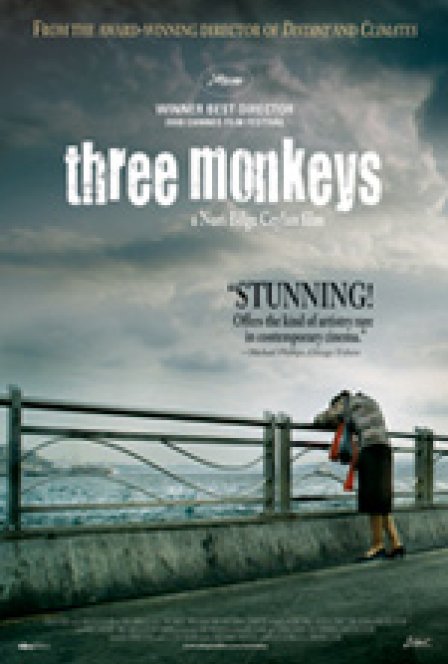Three Monkeys, Nuri Bilge Ceylan’s newest glacial opus, follows the devolution of a family after the father’s employer, a famous politician, gets involved in a hit and run. Eyüp (Yavuz Bingol), the father of the family, is offered an unknown “lump sum” of money to take the fall for him and say he was driving the car. The real brilliance behind Three Monkeys is that, on the surface, its plot seems straight out of film noir; the wife doubles as a sort of femme fatale. Yet, Three Monkeys is not paced like a film noir by any stretch of the imagination. It is, instead, a plodding meditation on the bonds of family and justice.
Ceylan’s film borrows a few conventions from the mystery genre but ensures, every step of the way, that we know we're watching a family drama. The director intentionally skirts the big moments, keeping the audience focused on the internal drama of the film. He never shows the accident. We see no police investigation, no trial or sentencing, no confession. What we do see is the conversation in which Servet, the politician, asks Eyüp to take the blame. When Eyüp’s son Ismail (Rifat Sungar) comes home after being beaten by unknown assailants, all Ceylan shows is the moment when his mother Hacer (Hatice Aslan) finds him sitting on the edge of his bed, his bleeding hands wrapped in a t-shirt. There is no fight, no flashback, no explanation, no questioning -- just a tenuous exchange of glance in which Ismail tries to force a smile.
That’s really the daring of Ceylan’s direction. He dares to make the greatest conflicts internal and shape the action of the film rise around small explosions that briefly externalize them. Over and over, Ceylan refuses to cut away from the strained eye contact between his characters, choosing to instead reveal how much drama and tension can reside in the subtleties of the human face.
Three Monkeys is full of incredibly beautiful photography, saturating the mise-en-scene the way Bresson or Bergman might. Ceylan's images are rife with pregnant stillness, framed beautifully and stripped of their color in such a way that the faces assume an almost gray hue and the bright colors pop out from the screen. There are few films that can successfully allow the cinematography to take such a prominent presence, and Ceylan manages to do without sacrificing the other aspects of his direction: The frame is never merely a pretty picture.
Some great performances, striking cinematography, and Ceylan’s masterful direction all come together to create a fascinating pseudo-noir that, despite riffing on many filmic tropes, emerges something entirely new. Three Monkeys moves at a snail's pace, and it takes a certain fortitude to continue to watch the lives slowly unravel as they do. Yet with all the beauty in this film, it’s hard to resist suspending our disbelief and discomfort to submit to Ceylan’s quietly shifting world.

